We will touch on the most challenging, profound, and also the most seductive aspect of the market: the counterintuitive nature of the market.
Written by: Dave
The secondary revelation series has unknowingly reached its final chapter. The entire series has been discussing tight reasoning and logical structures, but in this last article, we will touch on the most challenging, profound, and also the most seductive aspect: the counterintuitive nature of the market. This article will encompass all asset types in the capital market, not limited to cryptocurrencies, and friends from different backgrounds are welcome to take a look!
The secondary revelation series revolves around market trading. Trading is a three-dimensional structure:
The first dimension is technical analysis, which is like the sentences in an article; it is the basic skill. Mastering technical analysis can be considered an entry point, allowing you to become a shout-out trader on Twitter, where these traders generally lose money, but they can indeed earn continuously through commissions and advertisements.
The second dimension is position and system management. Having good technical analysis skills and effective position management qualifies you as a professional trader. We all know that humans have two emotional organs: one is the stomach, and the other is the position. If your stomach is upset, or your positions are erratically opened and closed, it indicates that your mindset and emotions have been disrupted. We often hear that maintaining a stable mindset in trading is essential; this is reflected in position management, and I hope to clarify the seemingly mysterious aspect of mindset management for you.
The final dimension is understanding the capital market. Mastering solid technical analysis fundamentals, stable position management, and profound market understanding can lead you towards becoming a trading legend like the likes of Eagle, Half-Wood Summer, Bitcoin King, or the historical figures like Livermore and Wyckoff. The same technical analysis pattern can yield completely opposite conclusions across different cryptocurrencies and time periods. Those who can buy are apprentices, those who can sell are masters, and those who can rest are experts. Knowing when to buy, sell, or rest is all related to market understanding.
The entire secondary revelation trilogy discusses the final dimension, which is understanding the capital market. Because technical analysis can be learned from textbooks or videos on YouTube, and emotional management requires character development, which varies from person to person and cannot be taught. Only market understanding is a core competency that must be accumulated through real market experience. The difference between top traders does not lie in their ability to read charts. Just like in the Kingdom of Heaven, where Sultan Saladin and King Baldwin IV of Jerusalem faced off, their duel did not involve swordplay:
Saladin: "I pray you pull back your cavalry and leave this matter to me."
Baldwin: "I pray you retire unharmed to Damascus. Reynald of Chatillon will be punished, I swear it. Withdraw, or we will all die here. Do we have terms?"
Saladin: "We have terms."

Cognition is the most powerful weapon. I hope everyone enjoys the secondary revelation series. Without further ado, let’s begin the main content.
1. No Logic
Retail investors have a bad habit of asking: Why is it rising? When you ask why it is rising, you subconsciously assume that this is a logical matter, something that can be immediately attributed. This is a cognitive bias regarding the capital market.
The truth is that, many times, the initial rise in asset prices is illogical—not just for small retail investors, but for the vast majority of market participants. The development process of a market trend often goes as follows:
A stock suddenly starts to rise within a certain time frame, and no one can find the reason; they can only watch the stock price continuously increase. Major financial news outlets will begin reporting on this stock (they do respond quickly to volatility), but the media will not provide any insightful conclusions; they merely report the striking fact that the stock price is soaring. This is the seductive, beautiful, yet dangerous and mysterious illogical phase.
With extensive media coverage and eye-catching price increases, this stock suddenly becomes a market hotspot, and everyone starts futilely searching for reasons. I call this behavior futile because such attributions are often not quality inductions but rather the emotional anxiety of retail investors who have missed out. People just want to give themselves a reason to buy this stock; they are simply afraid of missing further gains.
As a large number of participants begin this attribution process, one or several mainstream consensuses will slowly emerge in the market. After all, the market is made up of people; when many reasons are sought, one or two recognized ones will gain traction. At this point, the stock price often continues to rise, and since retail investors have found an explanation for the stock's rise, the resonance feedback loop between fundamentals and emotions drives even stronger increases.
The development of stage 3 is dangerous because the rising price validates the reasons retail investors have imagined for the increase. This self-fulfilling prophecy often inflates a significant bubble and deepens the retail investors' misguided cognition. At this point, people usually believe they have entered a new era, or that a new age is beginning, and the current rise is just the starting point, creating a scene of fervor and confidence. At this point in the story, a turning point should arrive.
An overheated market cannot be sustained indefinitely; stock prices often decline after overheating. This is torturous for retail investors because they have just received what they thought was a validated truth, only to have reality slap them in the face. At this time, the market's voices become complex; some believe the bubble has burst, some think it is a normal situation, and others see it as a buying opportunity. The market often continues its trend amid these divergences, and here I refer to the decline.
When stock prices fall, does the story end? Not at all. Public companies, funds, and ultra-high-net-worth individual investors have remained calm observers throughout this game. They are rationally assessing the pricing logic. If they genuinely believe this stock has the potential to rise, they will gradually build positions as the bubble dissipates, thus driving a new wave. This stage represents a change in valuation/pricing logic, which has long-term implications.
The first two stages of the above process represent illogical price increases, and I believe everyone has felt the importance of such illogical trading this year. Next, let’s take a recent hot example: Circle (CRCL).
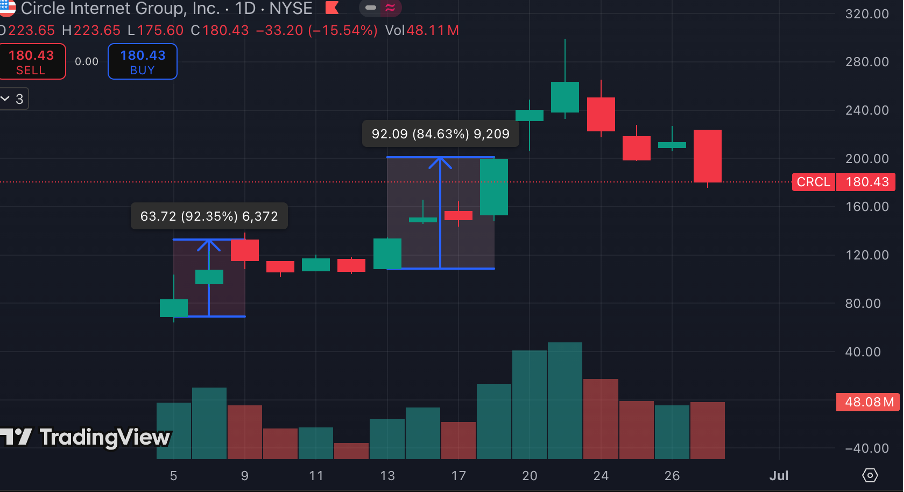
Circle provided us with a very clear opportunity to observe market sentiment. The stock price surged 90% within three days of its listing. You can search for the news from that time; during this period, people around the world were left dumbfounded. People in the crypto circle felt that this broken company should not be worth so much, while stock market participants could not understand what this broken company was doing. However, the crazy stock price indeed attracted the attention of the entire market.
This is the illogical surge phase; you cannot find a reason, cannot understand the business, and do not dare to buy, so you often miss out. It’s like young love; you feel a rush of emotions, you don’t know if the relationship can last, you don’t know if they will like you back, and you don’t dare to invest, so you often miss out.
Later, Circle's stock price underwent several days of consolidation and surprisingly did not drop. Everyone collectively observed during this phase. As the stock price further increased, various theories began to emerge.
You can see the second upward arrow drawn in the image; during this time, many explanations appeared, such as stablecoins, decentralized payments, replacing the banking system, new American hegemony, including the recent viral video of Mike Gange investing in Bitcoin, which was released during this time. It is very obvious that people began to seek reasons. These reasons are certainly not all self-deceptive; some of the logic may become serious considerations for institutional investors, but at this stage, the market presents a situation of mutual reflection, where the logic of attribution and the rising stock price spiral together, continuously pushing each other.
After the market overheats, the price begins to fall. What happens next is not the focus of this article. However, this sudden illogical surge is something everyone must adapt to and learn in this era, and it is a trend that we must strive to master.
At the very least, we need to change one habit: do not ask why it is rising when you see it has gone up. If our fundamental analysis only stays at the business level, without considering capital movements or market sentiment, and if we treat rigorous, quantifiable logic as the fundamentals, then there are too many things in this world that cannot be explained.
2. No Pricing
From Aristotle 2300 years ago to the atomic clocks used on spaceships today, humanity has a strong preference for certainty. First, it must be clear that certainty is indeed very useful. For example, cesium atoms have a characteristic: when they transition between two hyperfine energy levels, they emit electromagnetic waves at a specific frequency, which is very precise and stable. For me, this is of no use; I still need to drink three pounds of water every day; it’s just a characteristic of the atom, nothing worth studying. But the point lies in certainty; the characteristics of cesium atoms are very certain, and based on this point, scientists have made atomic clocks used on spaceships, with an annual error of no more than 1 second. Bitcoin is also very certain; there are only 2,100,000,000 of them, produced by a definite algorithm, so this string of invisible and intangible calculations becomes the global pricing system.
I digressed a bit, but the first point I want to convey is that certainty is indeed very useful for the development of human society. However, the focus of this article is actually on uncertainty. When people do not know how to price something, there often arises a vast space for profit and loss. Therefore, if an asset has the potential to enter an unpriceable range, and people do not know which set of logic to use to measure its value, one must be cautious, as significant opportunities often arise.
No pricing means no restrictions.
The examples in this article will be very broad. As mentioned at the beginning, it will encompass the entire capital market. In this chapter, we will provide an example of a "news" event that cannot be priced. It is also an ancient fear in the crypto circle: March 12.
On March 11, 2020, the World Health Organization (WHO) officially declared the COVID-19 virus a global pandemic. This was the first global pandemic a decade after the H1N1 flu in 2009. The capital market was completely unable to price this news; the world had changed too much in the past decade. The destructive power of this pandemic on the human body, its economic impact, and the potential death toll were unimaginable in the early stages because the virus was uncontrollable and difficult to predict. The results from several models were terrifyingly absurd. If you have any memory of the beginning of 2020, it truly felt like a biohazard crisis.
For the capital market, first, this is bad news, and it should fall. Second, we do not know how to price this news, meaning we do not know how far it will drop. So where will it fall to? The answer is that it will fall as far as emotions can take it.
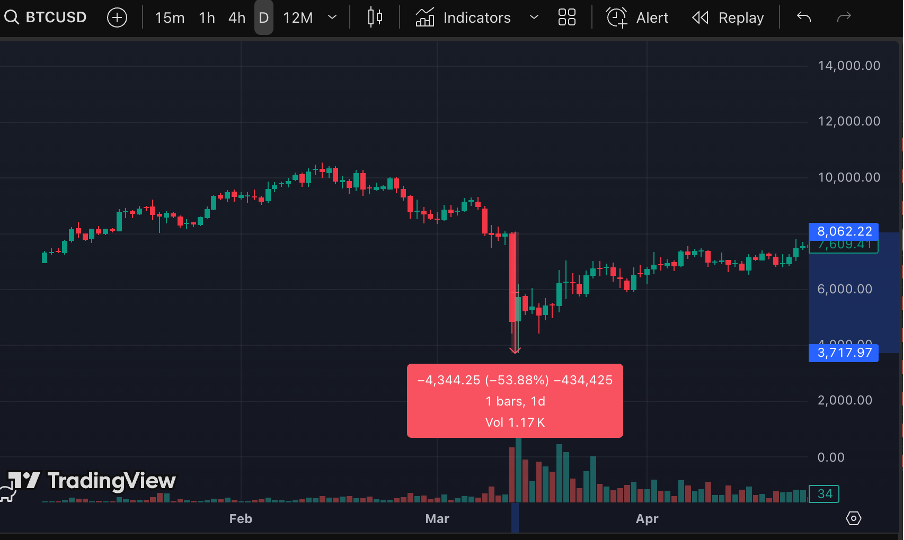
Bitcoin, which is now flourishing, once dropped 60% in just two days.
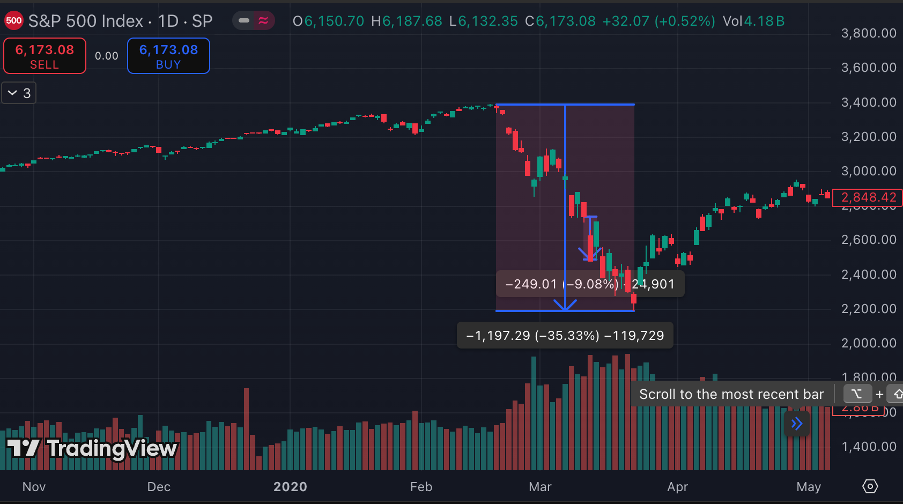
The eternally bullish S&P 500 fell 9% in one day and dropped 35% during the pandemic news digestion period. I remember there was a meme at that time saying that Buffett had experienced a stock market crash once in his first eighty years, but in just two months in 2020, he experienced four stock market crashes, leading him to say, "It seems I am still too young."
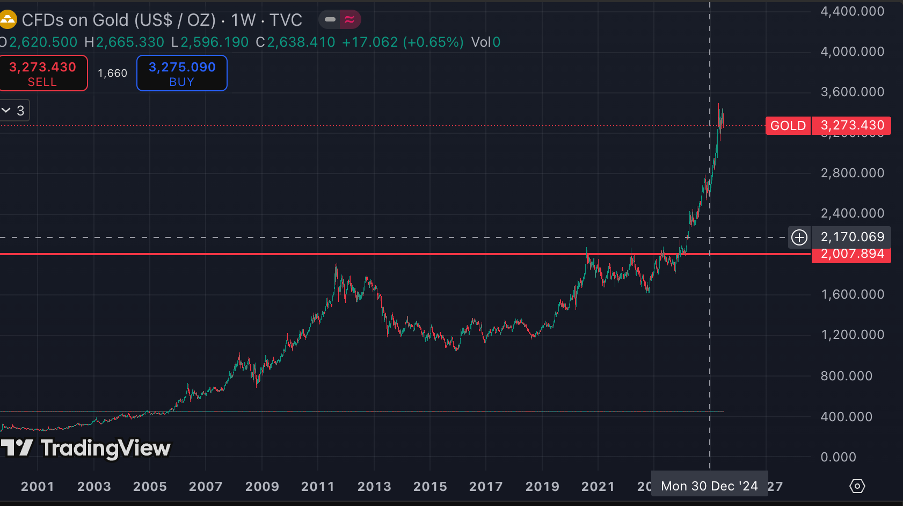
Let me give you a tangible example: one of the hottest trades in 2024-2025 is gold. We can clearly see that gold has been hovering around the red horizontal line, which represents the previous historical high, for a long time. In the absence of any significant driving events, the pricing logic at this time is essentially based on the previous high, leading people to think, "Oh, I should sell or wait." However, once the price breaks through the historical high, we suddenly do not know how to price it. How much should gold be worth? Everyone looks confused. Dear readers, do not think that pricing must involve a rigorous formula; as long as you can find a reason to convince yourself, you are still within a pricing range. But for gold, it has entered an unpriceable zone, and at this moment, it is rising the fastest and the most.
The situation with Bitcoin is very similar. We have been hovering around the historical high of about $70,000 in 2024 for a long time. After breaking through, it shot straight to $100,000 because $100,000 is a psychological price point for normal humans; it looks good. However, after Bitcoin officially breaks through $100,000, how should we price it? Now, it is impossible to find an answer. Various imaginative theories seem to all make sense:
Historical factions believe this cycle's peak is at $120,000.
Pricing factions link Bitcoin to gold, suggesting that according to the leader's law, Bitcoin's market cap should be one-third of gold's, which is how many traditional institutions view it.
Early geeks and fundamentalists might think the peak is at $1,000,000.
Narrative factions believe Bitcoin is the anchor for the future dollar, with no upper limit.
In any case, there is a rationale for everything; just pick a flavor you like. I just want to say that if everyone does not know how to price something, it often has huge potential for upward or downward movement.
3. Despair Reversal: "Upsets" in the Capital Market
There is a saying: buy when no one is paying attention, sell when the crowd is roaring. This phrase illustrates the counterintuitive nature of the capital market well; big opportunities often arise in overlooked niches, while popular opportunities are limited.
Especially during moments of despair reversal, significant returns can be achieved. Let me give you two direct examples. The first is the 1998 World Cup final. Readers might be confused: what is Dave talking about? First, I must explain the definition of the virtual economy. The virtual economy includes not only the financial and real estate sectors we are familiar with but also sports economics, gambling, and collectibles. Therefore, sports are essentially similar to finance; they are also a form of virtual economy. The 1998 World Cup final is a classic example of an "upset."
Before the match, the whole world unanimously believed that Brazil would win against France by a large margin. At that time, Brazil had a super luxurious lineup, with players like Ronaldo, Carlos, and Taffarel, leaving no weaknesses in any position. Moreover, Brazil's main player, Ronaldo, was the best performer in that World Cup, with four goals and three assists. Historically, Brazil had never lost once they reached the World Cup finals.
The popularity of Brazil led to massive betting on their victory. It was rumored that the odds reached 1 to 6, and this match alone took away $25 billion in bets in Asia, meaning many retail investors were betting against the bookmakers. At the same time, bookmakers would continue to adjust the odds every time France scored, meaning they would increase the odds for Brazil not scoring a single goal, and global betting amounts followed the bookmakers' adjustments. In the end, France won 3-0 against Brazil. Ronaldo, the team's core player, was absent throughout the match, and the team doctor later admitted that "a medication error" caused him to have adverse reactions, leading to a very low team morale.
Of course, the French parliament later investigated this match-fixing case, concluding that there was no match-fixing, and a series of clarifications were made. However, this betting incident remains a classic to this day, and you can still see references to the 1998 incident in movies about gambling.
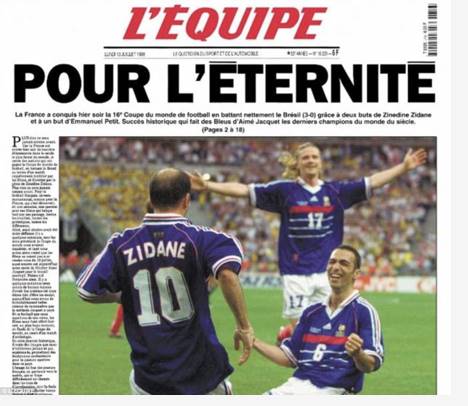
So, when betting on football, go against the trend; don't let capital set you up.
Let me give you another tangible example: Ethereum. After a long decline and a rather poor price performance, the vast majority of market participants, including myself as a professional speculator, lost confidence in ETH. At this point, using the term "despair" is absolutely fitting. Cold assets in despair may not necessarily rise, but if they do, it will be earth-shattering.
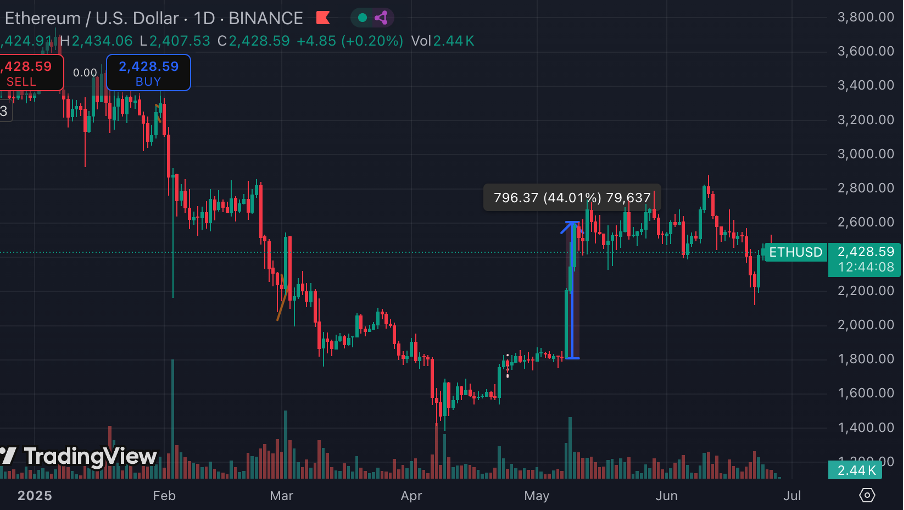
In just three days, the second-tier coin in the crypto circle surged 44%, leaving even the annual dark horse SOL dumbfounded. This is the powerful effect of despair reversal. Buffett said, "I am greedy when others are fearful, and I am fearful when others are greedy." This succinctly reveals the secret of upsets and hot trends.
4. Buy Expectations, Sell Realities
This is what we often refer to as expectations materializing. Good news materializing turns into bad news, and bad news materializing turns into good news. If one cannot understand this counterintuitive aspect of the capital market, they may feel confused by some phenomena related to price information linkage, such as why a good news event occurs but the stock price still falls. The reason actually lies in the quantum transition from expectation to reality. Expectations are the most seductive thing; if I could leave only one word for the secondary market, I would choose "expectation." Reality is not seductive; it is often stark. Therefore, when expectations turn into reality, and something seductive becomes something unappealing, we need to interpret the news in reverse.
Some classic examples include blockchain public chain upgrades. When the news of a public chain upgrade is announced, people will have expectations for the performance of the upgraded blockchain, thus driving up the prices of related tokens. However, when the public chain officially completes the upgrade and the high-speed, efficient functions we anticipated are realized, the token prices may actually fall.
One of the most classic examples is the approval of the Bitcoin ETF on January 10, 2024. At that time, I was interning in Shanghai and actually set an alarm for 3:00 AM to check the news. During the expectation phase from the end of 2023 to the beginning of 2024, Bitcoin's price rose from about $30,000 to around $48,000, strongly driven by "buying expectations." On January 10, 2024, the SEC announced the approval of the ETF. Then:
- Buy Expectations, Sell Realities
This is what we often refer to as expectations materializing. Good news materializing turns into bad news, and bad news materializing turns into good news. If one cannot understand this counterintuitive aspect of the capital market, they may feel confused by some phenomena related to price information linkage, such as why a good news event occurs but the stock price still falls. The reason actually lies in the quantum transition from expectation to reality. Expectations are the most seductive thing; if I could leave only one word for the secondary market, I would choose "expectation." Reality is not seductive; it is often stark. Therefore, when expectations turn into reality, and something seductive becomes something unappealing, we need to interpret the news in reverse.
Some classic examples include blockchain public chain upgrades. When the news of a public chain upgrade is announced, people will have expectations for the performance of the upgraded blockchain, thus driving up the prices of related tokens. However, when the public chain officially completes the upgrade and the high-speed, efficient functions we anticipated are realized, the token prices may actually fall.
One of the most classic examples is the approval of the Bitcoin ETF on January 10, 2024. At that time, I was interning in Shanghai and actually set an alarm for 3:00 AM to check the news. During the expectation phase from the end of 2023 to the beginning of 2024, Bitcoin's price rose from about $30,000 to around $48,000, strongly driven by "buying expectations." On January 10, 2024, the SEC announced the approval of the ETF. Then:
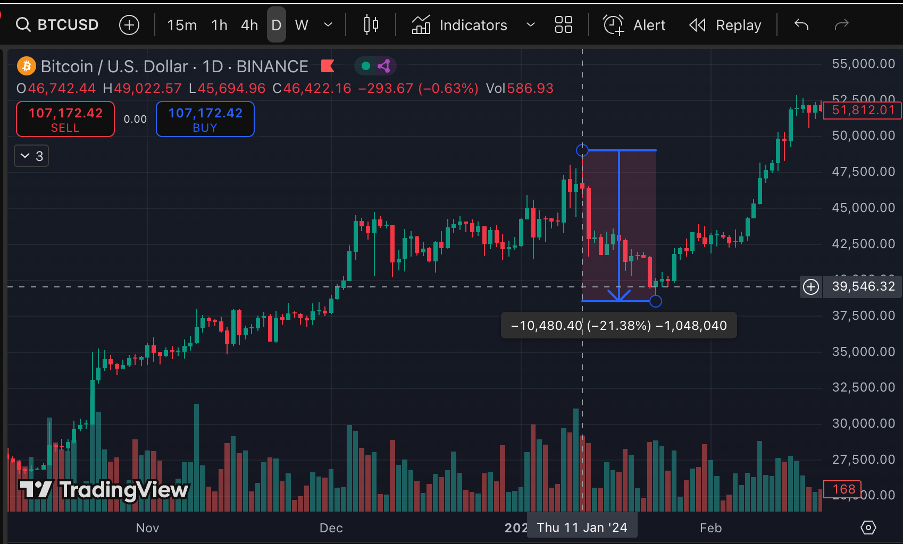
Interested friends can search for why Bitcoin's price fell after the ETF approval; detailed attribution analyses have been conducted on this event, and they are well articulated. However, if we look at it purely from an intuitive perspective, we cannot understand it. Before the ETF approval, there was no inflow of off-market funds; only after the ETF approval could off-market funds flow in. So why did the price rise when there was no inflow of funds, and then start to fall after the inflow? Expectations, still expectations.
To summarize, if the news is unexpected, it can be interpreted logically; for example, if the Federal Reserve suddenly announces a rate cut, which is unexpected, the market rises. If the news is expected, it should be interpreted in reverse; for instance, when the gold ETF (GLD) was launched in 2004, the price of gold also experienced a short-term pullback after the launch because the market had already digested the good news in advance.
Conclusion:
The entire secondary revelation series revolves around rigorous reasoning and logic, but this article deviates from the usual writing style to discuss the irrationality in the market. It is necessary for us to recognize the paradigm shift from a macro perspective. Since the turning point of the economic cycle in 2020, the world has entered a state of significant uncertainty: the Russia-Ukraine war, the 20th National Congress of the Communist Party of China and pandemic policies, the ongoing conflicts in the Middle East, and Trump's return to the White House have injected considerable and uncomfortable turbulence into the macro economy.
Irrational markets are not a new phenomenon. As early as in Soros's book "The Alchemy of Finance," the concept of market reflexivity was proposed, challenging the rational market hypothesis that has persisted for a century. However, in today's world, the explosion of information brought about by technological advancements, political uncertainty and polarization, and the changes in economic foundations since the Third Industrial Revolution affecting the new generation's consumption perspectives—these three different levels of factors interact, and the triple resonance amplifies the impact of emotions, causing the market to deviate significantly from rational valuation lines.
The subtle changes in asset trading development models actually reflect changes in the structure of market participants. Throughout the history of the financial market, we seem to have transformed from classical investors with an artistic flair graduating from the philosophy department at Cambridge University to modern investors with a technical flair graduating from MIT's statistics department, and now to individualistic investors who dropped out of Hong Kong University of Science and Technology to pursue rock music. From Buffett to Ken Griffin to labubu.
These multiple transformations force us to confront human nature—primitive human nature. It is so complex, so vague, so inscrutable, yet it contains such great opportunities. It is like a pirate crew encountering Treasure Island, Emperor Qin encountering the elixir of life, or Bai Suzhen meeting Xu Xian. It is a perilous journey where one may gain enlightenment in the morning and perish by evening. This article aims to use simple words to unveil a small part of this vast topic.
免责声明:本文章仅代表作者个人观点,不代表本平台的立场和观点。本文章仅供信息分享,不构成对任何人的任何投资建议。用户与作者之间的任何争议,与本平台无关。如网页中刊载的文章或图片涉及侵权,请提供相关的权利证明和身份证明发送邮件到support@aicoin.com,本平台相关工作人员将会进行核查。




